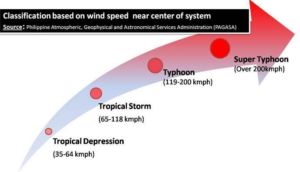Published on: December 18, 2021
SUPER TYPHOON
SUPER TYPHOON
NEWS
Super Typhoon Rai hammers Philippines
DETAILS
What is Typhoon
- Local name for Tropical storm in the Western Pacific and the South China Sea
- Other Names
- Cyclones in the Indian Ocean
- Hurricanes in the Atlantic
- Willy-willies in Western Australia
- CLASSES

Conditions favourable for the formation and intensification
- Large sea surface with temperature higher than 27° C.
- Presence of the Coriolis force to create a cyclonic vortex (hence they do not form at Equator because Coriolis force is zero)
- Small variations in the vertical wind speed.
- A pre-existing weak low- pressure area or low-level-cyclonic circulation.
- Upper divergence above the sea level system.
Characteristics
- A roughly circular area of comparatively light winds and fair weather found at the centre of a severe tropical cyclone is known as Eye of the cyclone. The eye is the region of lowest surface pressure and warmest temperatures as air descends at the centre. The eye is surrounded by the “eye wall”, the roughly circular ring of deep convection, where winds blow the fastest.
- Tropical cyclones have a compact size, ranging from 80 km to 2000 km in diameter.
- The latent heat of evaporation released by the condensation of moist rising air over oceans is the driving engine for tropical cyclones.
- These cyclones cannot sustain over land because the latent heat of evaporation is not available. Therefore, they dissipate after they make landfall.
- Tropical cyclonic systems move in a parabolic path towards west. Then they get deflected by the Coriolis force

